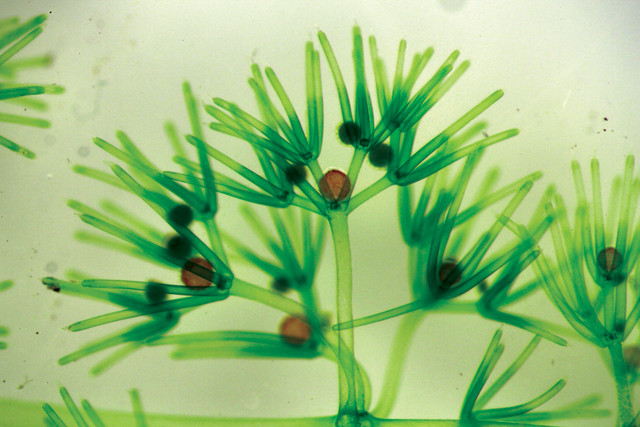
by Lucas Joel Thursday, January 7, 2016

Nitella hyalina is a stonewort and a member of the charophyte green algae family. No known charophyte alga has symbiotic associations with mycorrhizal fungi, but N. hyalina and other stoneworts do develop root-like rhizoids that anchor the thallus in sand and mud, and probably frequently interact with fungi. The frame is about 5 millimeters tall. Credit: Charles F. Delwiche, University of Maryland, all rights reserved.
Plants colonized land between 450 million and 420 million years ago, and, once there, they drastically altered terrestrial landscapes and provided resources for animals leaving the oceans around the same time. One adaptation that helped plants gain a foothold on land is a symbiosis with fungi known as arbuscular mycorrhizae (AM), which help plants acquire water and key nutrients from the soil and are still associated with most land plants today. In return, plants provide the fungi with bioavailable carbon produced during photosynthesis. When this symbiosis evolved has remained unclear, but researchers recently discovered that it likely has roots in a group of freshwater algae ancestral to land plants.
For the symbiosis to work, a chemical communication pathway that helps fungi connect to and colonize plant root cells is needed, says Pierre-Marc Delaux of the Plant Sciences Research Laboratory in France, and lead author of the new study published in Proceedings of the National Academy of Sciences. “We found that this pathway … existed before plants colonized land,” Delaux says, and then “land plants built on this pre-existing pathway.”
Delaux and his team uncovered the origins of the pathway — in which a specific plant enzyme acts as a beacon that helps the fungi find their way into the plant — by studying genomes from a group of modern-day freshwater green algae called charophytes, which are thought to be ancestral to land plants.
“These structurally simple organisms have remarkably complex developmental and regulatory pathways analogous to those of plants,” says Charles Delwiche, a botanist at the University of Maryland who was not involved in the study. “It’s extraordinary to realize how many key plant systems, like this [communication] pathway, are present within their close charophyte relatives.”
Why the pathway evolved in charophytes is still uncertain, as they have no known symbiosis with fungi. “There are many possibilities, but without knowing more about the biology of the algae — which remains a relatively understudied group overall — it is difficult to identify the nature of the trait’s origins,” Delwiche says.
What is clear, though, is that while the pathway did not initially evolve as an adaptation for terrestrial life, it has proven abundantly useful for land plants.
When plants began colonizing land, the symbiosis was one of the main features that helped plants survive in terrestrial environments, Delwiche says. In the rock record, he says, the plant-fungus association is discernible in fossils from the 410-million-year-old Rhynie Chert in Scotland, for example, which preserves fossils of AM fungi in a very similar association to what occurs in modern plants.
Today, more than 80 percent of land plants rely on the AM symbiosis. Studying the symbiosis and revealing its origins have potential economic benefits, says Jean-Michel Ané of the University of Wisconsin at Madison and a co-author of the study. “By understanding the building blocks of symbiotic associations, we can engineer our own beneficial associations between organisms like cereal [grains] and bacteria,” Ané says, which could help increase cereal crop yields.
© 2008-2021. All rights reserved. Any copying, redistribution or retransmission of any of the contents of this service without the expressed written permission of the American Geosciences Institute is expressly prohibited. Click here for all copyright requests.